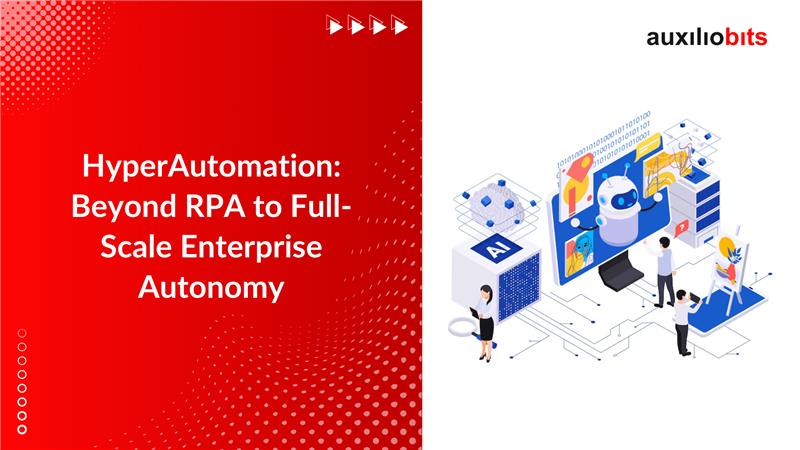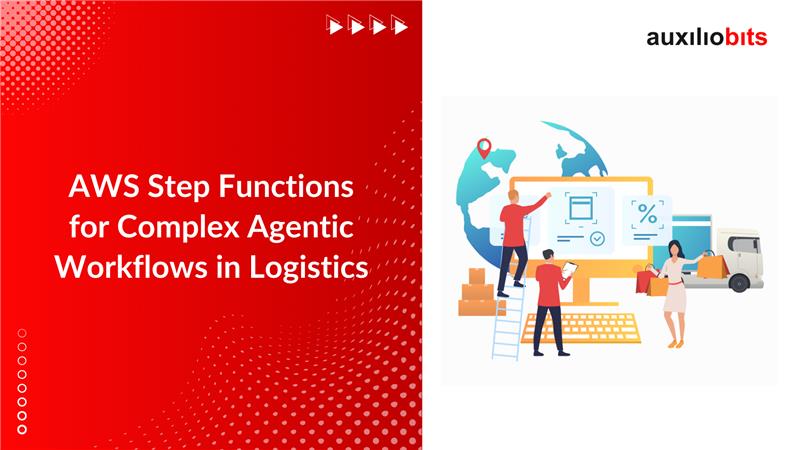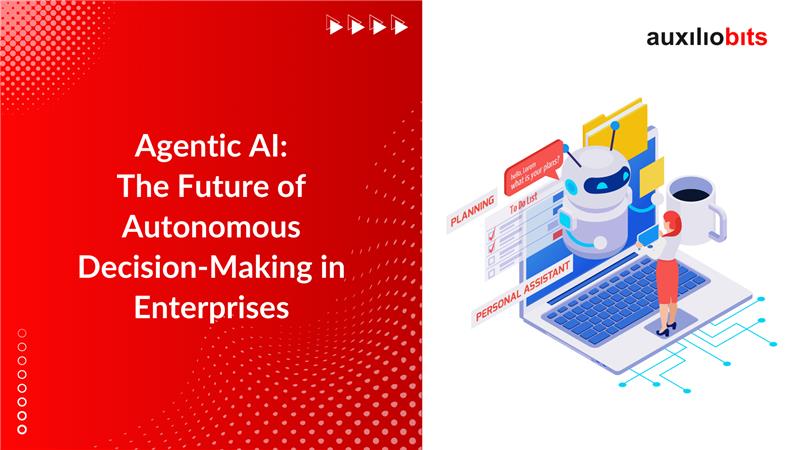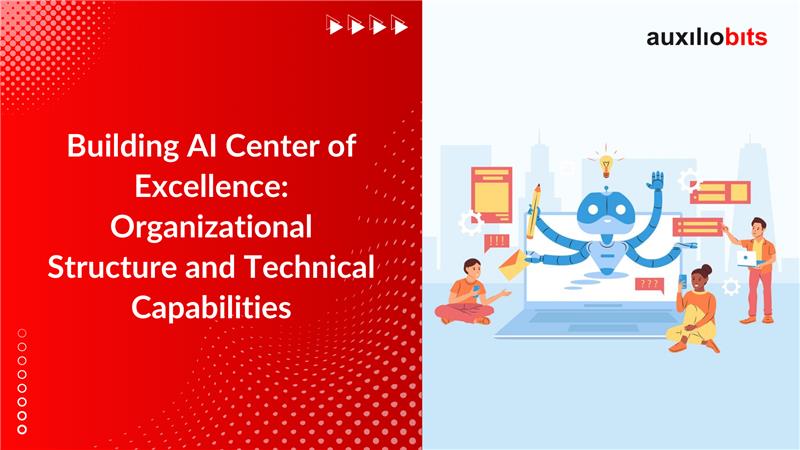
Success in the current business environment is not possible for everyone until and unless they adapt and enhance themselves as per market changes and customer requirements. Therefore, to climb the ladder of success, firms should seek methods to help them lessen costs, improve productivity, and streamline operations. One such beneficial method is HyperAutomation. Unlike robotic process automation, which mainly focuses on automating repetitive tasks, HyperAutomation does much more. It gathers all the advanced technologies, including process mining, natural language processing, machine learning, and artificial intelligence, to offer top-notch results. All these tools together allow businesses to automate their tasks. In addition to this, the tools also allow them to analyze, optimize, and make wise decisions, developing an efficient and autonomous firm.
Also read: Generative AI for Dynamic Data Modeling in Enterprise Cloud Solutions
Who Can Benefit from HyperAutomation?
Because HyperAutomation is considered a transformative force for firms, let us understand who can benefit from implementing HyperAutomation. This will help you know whether your business can implement the technology. Below are listed some of them:
1. Companies with Difficult, Repetitive Procedures
Big firms that manage several interconnected procedures can benefit from implementing HyperAutomation. Regularly performed tasks, including customer inquiries, invoice processing, and data entry, are suitable for automation. When such tasks are automated, companies can free up their employees. In addition, they will reduce human mistakes. Their workflows will improve, and firms will be able to recognize optimization opportunities.
2. Companies Seeking to Optimize Operational Efficiaousy
Regarding orchestrating end-to-end workflows, HyperAutomation offers a unified platform that helps businesses. It allows them to improve efficiency by integrating several systems and automating manual tasks. It also reduces reliance on disparate tools. With the help of automation, companies can optimize human resource management, supply chains, and financial operations, resulting in better productivity and faster turnaround times.
3. Any Industry Handling Huge Volumes of Data
Specific industries manage vast amounts of data. Therefore, this data asks for quick and suitable processing. HyperAutomation’s advanced data analytics and intelligent decision-making abilities suit such cases. For example, HyperAutomation will automate fraud detection and regulatory compliance if we talk about the finance industry. It will improve patient management and support diagnostic analysis in the healthcare sector.
4. Businesses Seeking to Reduce Human Errors and Decision-Making Time
HyperAutomation minimizes human intervention in repetitive decision-making processes, ensuring greater accuracy and consistency. AI algorithms analyze data in real time to provide actionable insights, enabling faster and more informed decisions.
When Should Enterprises Implement HyperAutomation?
HyperAutomation has too many perks to provide. Nevertheless, identifying a suitable time to implement it is essential to making the best possible use of it. Therefore, we have listed some of the
1. When Manual Processes Cause Delays and Inefficiencies
Enterprises often struggle with outdated manual processes, leading to bottlenecks, errors, and increased operational costs. Tasks like data entry, invoice processing, and report generation consume valuable employee time and increase the risk of human error. HyperAutomation offers a seamless solution by automating these repetitive tasks, allowing employees to focus on more strategic initiatives.
For instance, finance departments can leverage HyperAutomation for automated reconciliation, reducing processing time from days to minutes. Similarly, HR teams can streamline onboarding processes by automating paperwork and verification tasks. Organizations experiencing process delays and operational inefficiencies should prioritize HyperAutomation to achieve faster, more accurate results.
2. During Digital Transformation Initiatives
igital transformation is a key driver for adopting HyperAutomation. Enterprises embarking on digital initiatives often encounter legacy systems and siloed operations that hinder progress. HyperAutomation bridges these gaps by integrating with existing IT infrastructure, enhancing connectivity, and automating end-to-end workflows.
Whether implementing cloud solutions, adopting customer experience platforms, or modernizing supply chain management, HyperAutomation acts as a catalyst. Streamlining data flow across departments and enabling real-time insights accelerates the digital transformation journey.
3. When Real-Time Data Insights Are Needed
In today’s data-driven world, organizations need actionable insights for informed decision-making. However, manually deriving meaningful insights from vast datasets is time-consuming and prone to errors. HyperAutomation harnesses AI-powered data analytics to provide real-time insights, detect patterns, and predict outcomes.
For example, HyperAutomation can analyze customer purchasing behavior in the retail sector to optimize inventory management and personalized marketing campaigns. In financial services, it can detect fraudulent activities through continuous data monitoring. Enterprises that require real-time visibility and predictive analytics to remain competitive should prioritize HyperAutomation.
4. Maintain Competitiveness in Evolving Markets
Market dynamics are constantly evolving, requiring enterprises to be agile and responsive. Organizations that fail to adapt risk losing their competitiveness. HyperAutomation enables enterprises to respond swiftly to market changes by automating decision-making processes, optimizing resource allocation, and predicting customer demands.
In manufacturing, predictive maintenance powered by HyperAutomation reduces downtime and ensures operational continuity. In logistics, automated route optimization enhances delivery efficiency. Moreover, organizations can quickly scale operations to meet fluctuating demands without compromising quality.
Also read: The Role of a HyperAutomation CoE in Standardizing Automation-as-a-Service Across Enterprises
When Should Enterprises Implement HyperAutomation?
HyperAutomation has emerged as a strategic solution for enterprises looking to enhance operational efficiency, minimize costs, and drive innovation. It goes beyond traditional automation by integrating technologies like Artificial Intelligence (AI), Machine Learning (ML), Robotic Process Automation (RPA), and advanced analytics. However, determining the right time to implement HyperAutomation is crucial for maximizing its benefits. Below are key scenarios that indicate when enterprises should consider adopting HyperAutomation.
1. When Manual Processes Cause Delays and Inefficiencies
Enterprises often struggle with outdated manual processes, leading to bottlenecks, errors, and increased operational costs. Tasks like data entry, invoice processing, and report generation consume valuable employee time and increase the risk of human error. HyperAutomation offers a seamless solution by automating these repetitive tasks, allowing employees to focus on more strategic initiatives.
For instance, finance departments can leverage HyperAutomation for automated reconciliation, reducing processing time from days to minutes. Similarly, HR teams can streamline onboarding processes by automating paperwork and verification tasks. Organizations experiencing process delays and operational inefficiencies should prioritize HyperAutomation to achieve faster, more accurate results.
2. During Digital Transformation Initiatives
Digital transformation is a key driver for adopting HyperAutomation. Enterprises embarking on digital initiatives often encounter legacy systems and siloed operations that hinder progress. HyperAutomation bridges these gaps by integrating with existing IT infrastructure, enhancing connectivity, and automating end-to-end workflows.
Whether implementing cloud solutions, adopting customer experience platforms, or modernizing supply chain management, HyperAutomation acts as a catalyst. By streamlining data flow across departments and enabling real-time insights, the digital transformation journey is accelerated.
3. When Real-Time Data Insights Are Needed
In today’s data-driven world, organizations need actionable insights for informed decision-making. However, manually deriving meaningful insights from vast datasets is time-consuming and prone to errors. HyperAutomation harnesses AI-powered data analytics to provide real-time insights, detect patterns, and predict outcomes.
For example, HyperAutomation can analyze customer purchasing behavior in the retail sector to optimize inventory management and personalized marketing campaigns. In financial services, it can detect fraudulent activities through continuous data monitoring. Enterprises that require real-time visibility and predictive analytics to remain competitive should prioritize HyperAutomation.
4. Maintain Competitiveness in Fast-Evolving Markets
Market dynamics are constantly evolving, requiring enterprises to be agile and responsive. Organizations that fail to adapt risk losing their competitive edge. HyperAutomation enables enterprises to respond swiftly to market changes by automating decision-making processes, optimizing resource allocation, and predicting customer demands.
In manufacturing, predictive maintenance powered by HyperAutomation reduces downtime and ensures operational continuity. In logistics, automated route optimization enhances delivery efficiency. Moreover, organizations can quickly scale operations to meet fluctuating demands without compromising quality.
Which Technologies Drive HyperAutomation?
HyperAutomation is powered by a sophisticated ecosystem of advanced technologies. These integrated solutions work together to automate complex business processes, enabling seamless end-to-end automation. Here are the key technologies driving HyperAutomation:
1. Robotic Process Automation (RPA)
RPA serves as the backbone of HyperAutomation by automating rule-based, repetitive tasks. It mimics human actions by interacting with applications and systems without requiring significant changes to the existing infrastructure. RPA bots streamline tasks like data extraction, data entry, and report generation, significantly reducing manual effort and errors.
2. Artificial Intelligence (AI) and Machine Learning (ML)
AI and ML empower HyperAutomation by providing intelligent decision-making capabilities. AI algorithms analyze vast datasets to identify patterns, predict outcomes, and automate complex tasks. ML models continuously learn and improve, enhancing accuracy and efficiency over time. AI-driven solutions like natural language processing (NLP) and computer vision are also integral to understanding and processing unstructured data.
3. Process Mining and Task Mining
Process mining tools analyze enterprise processes to identify inefficiencies and automation opportunities. Examining event logs and system data provides insights into how workflows operate. Task mining, on the other hand, captures user interactions to suggest further automation possibilities. Together, these technologies ensure HyperAutomation targets the most impactful processes.
4. Intelligent Document Processing (IDP)
IDP uses AI-powered capabilities to extract and interpret data from structured and unstructured documents like invoices, contracts, and forms. Optical Character Recognition (OCR) and NLP enable accurate text extraction, enabling automated data validation and processing. IDP significantly reduces document-handling time and minimizes human intervention.
5. Low-Code and No-Code Platforms
Low-code and no-code platforms empower business users and citizen developers to build and deploy automation solutions without extensive coding knowledge. These platforms provide intuitive interfaces, drag-and-drop features, and pre-built templates, accelerating automation deployment and reducing IT dependencies.
6. Business Process Management (BPM)
BPM platforms orchestrate and manage end-to-end business workflows. They integrate automated processes, monitor real-time performance, and ensure seamless collaboration between human and digital workers. BPM tools ensure that computerized processes align with business goals and compliance standards.
7. Advanced Analytics and Reporting
HyperAutomation solutions often include advanced analytics capabilities that provide actionable insights through interactive dashboards and reports. These insights help decision-makers monitor process performance, detect anomalies, and make data-driven improvements.
Conclusion
Enterprises should implement HyperAutomation when faced with operational inefficiencies, during digital transformation efforts, when real-time insights are essential, or to remain competitive in dynamic markets. By leveraging HyperAutomation, organizations can optimize processes, enhance decision-making, and drive innovation.
Explore how Auxiliobits’s HyperAutomation solutions can transform your business operations today.






